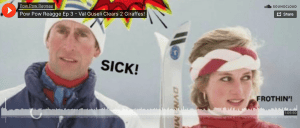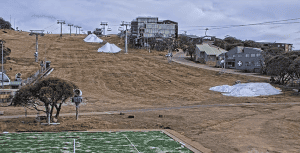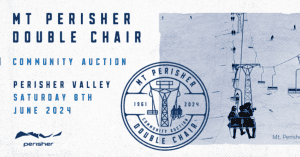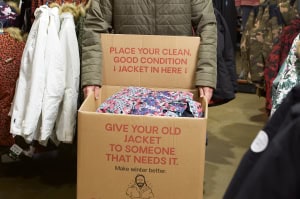Boothy’s Blog – Is skiing killing snowboarding?
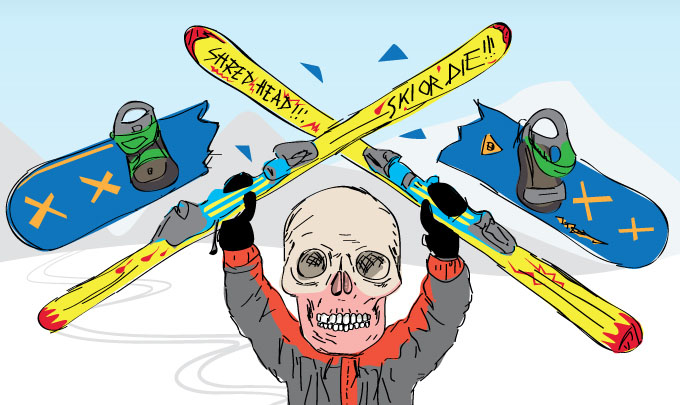
Illustration by Russell Smith
Mountainwatch | Chris Booth
When I was four years old, dad took me snowboarding. It was the early ’90s and snowboarding was exploding and he was right into it. Only thing was, there weren’t any snowboard boots in tiny kids sizes available at the time, so all I had were my rear-entry ski boots. It didn’t work. I could shuffle around at the bottom of Perisher, but no matter how much I tried, I couldn’t make it up the number 1 T-bar on Front Valley. I remember the snowboard instructor saying to my dad: “Five seems to be the age where they get it, they are just that much stronger.” So dad brought me back the next year and gave me another go, in the meantime he also managed to find me some SOREL boots – the closest thing to a kid’s snowboard boot at the time. It worked; I made it up the number 1 T-bar, and by lesson number 2 I was cruising all over Perisher. I can imagine what a little shit I looked like blasting around the resort, cutting people off, getting stuck on the flats, not being able to do my bindings up, and just being this stoked out five year old with a runny nose and really wet gloves. I was in love.
For the next five or six years I snowboarded far more than I ever skied. It was something my dad and I did together. Every year he would bring me along to the annual Burton Demo Week (they used to host a week back then) where I could check out all the fresh gear and watch the grown-ups shred the hill. One year they had a Burton Rad Air, the ultimate kids snowboard, I swear I coveted that thing more than anything in my life, and when Burton let me keep it at the end of the week, I literally lost my shit.
But then something happened; I stopped snowboarding.
I’ve never really asked myself why, at least not until recently, when overseas industry media began reporting – and commenting – on new data indicating that snowboarding’s popularity had not only plateaued, but appeared to be in decline.
The data came from two sources: the Snow Sports Industry America (SIA) report (published annually on their website) and a National Ski Area Association (NSAA) Report titled “The Rise and Stall of Snowboarding.” It was big news. The New York Times reported on it, as did the Boston Globe, and then a flood of opinion followed online, from the well-informed and thoughtful to the downright idiotic. I’ll leave all that for you to Google around on, but essentially the two points were this:
1. Snowboarding, which had grown dramatically year-on-year to make up 26.2 % of the overall ski resort participant base, has stalled, and even fallen, since 2009.
2. The number of snowboarder days has fallen from 7.6 days a year at its peak in the late ‘90s to 6.1 days today.

Snowboarding peaked at 26.2% of total visits in winter 09/10 and has declined since.
Of all the theories going around the interwebs, four explanations seem to emerge as the most common:
1. The boom generation of snowboarding is getting older, they have kids and mortgages and are snowboarding less.
On one level this is a fairly natural outcome and completely understandable. But on another level, perhaps a deeper level, this is worrying. Sure, the boom generation is moving on and the numbers reflect that. But where is the next generation? The one that doesn’t have a mortgage and doesn’t give a shit about their career yet. And why aren’t those numbers counterbalancing the boom generation decline? The single, irresistible conclusion is a scary one, people haven’t picked up snowboarding in as great a number as the boom generation. So why might that be happening?
2. You can’t learn snowboarding as a little tacker.
In 2013 Annie Fast, previously Editor In Chief at Transworld Snowboard Magazine, wrote in Outside Magazine that “[the] bigger challenge for snowboarding is just bringing people in. Ever try putting a kid under the age of five into a resort snowboard lesson? It can’t be done. The majority of resorts teach skiing only—but this is changing. Burton Snowboards has partnered with resorts on snowboard-specific Riglet Parks for 3- to 6-year-olds, of which there are now 28. And Burton’s already built 185 of their learn-to-ride parks worldwide. The company also just beefed up its line of kids’ gear, introducing a 70 cm snowboard for riders as young as three. K2 and Ride are in on the game, too, offering affordable packages for kids.”
This reminds me of my own experience of not getting snowboarding the first time round cause I was too young and couldn’t access the right equipment. If it wasn’t for my old man’s froth on snowboarding I might never have come back the next year and tried again.
3. Snowboard marketing is too narrow.
Pick up a snowboarding magazine and what do you see? Watch any of the latest release snowboarding films and what do you see? Snowboarding has always been and continues to be marketed as a sport for teenagers who spew and get heaps of air. That’s rad, but does it reflect where the sport is really at today? Snowboarding media is on the whole much more organised and sophisticated than ski media, but it’s all about sponsored pro’s doing front 3’s off cliffs into pillows in the Whistler backcountry and highly consequential urban features in Minnesota. Sick, but tell me, how many people can actually tap into that? I mean really, on a meaningful level. Skiing by contrast has so many ways people can plug into it, be it carving, or racing, or cross-country. Young dudes getting air is just a niche within the greater whole. A common point out there in opinion land is that snowboard marketing could be beginning to alienate more people than it is reaching out to.
4. Skiing became relevant again.
In 2012 Richard Hiller wrote in SBC Business, “It’s certainly clear to notice freeskiing’s rise. Twin-tip ski sales have seen a dramatic increase from approx 81,462 units sold in 2009/2010 to approximately 102,657 units sold in 2010/2011. Snowboarding sales on the other hand, despite making four per cent more in revenue, saw a four per cent decrease in units sold.

Nah it’s not really. Nice headline though. Image:: supplied.
I’m actually not sure if that can be used as proof to support the suggestion that snowboarding’s decline is tied to the rise of freeskiing. I think I learnt about this at uni, it’s called a ‘spurious relationship’, where two events are wrongly inferred to have a causal connection because of either coincidence or the presence of other ‘lurking’ variables (like for example, three shitty consecutive snow seasons in California where 23% of snowboarders live, or how the US recession hit younger people harder than older, more affluent people). So I don’t think it’s fair or correct to say that snowboarding’s decline is because of freeskiing’s rise. But, when I look around the terrain park and I see young kids on skis everywhere, I can’t help but think that if freeskiing never happened they would probably just be on snowboards.
The story in Australia.
So that’s the overseas situation, but I’m interested to know whether the same thing is happening here at home. Now, if I was a great journalist I would have gone out and interviewed a bunch of retailers and industry people and combed through the data, but being a skibum I just asked my old man. He and mum have owned and operated Snow Skiers Warehouse in Sydney for twenty something years and actually stocked the first snowboards to arrive to the Australian market.
“Our experience is people are coming to snowboarding first” he says, “we outsell snowboards to skis every year, and that’s growing more and more each year, to a point where we can’t adapt quick enough.”
When asked why that is, he pointed to new markets; “We are getting a lot young people from Asian backgrounds who have been exposed to snowboarding all their lives through the media, but are from families who have never or rarely been into the snow, and now that they have the chance to go themselves they want snowboards.”
On whether skiing is affecting snowboarding’s growth his perspective is interesting: “What we’re actually seeing is that all the older guys are happy to jump back on skis, it’s more the early 20-year-olds who have never been to the snow before who are picking up snowboards.”
So there you go, in Australia we may just be seeing the reverse situation.
What I reckon.
Unfortunately, I still don’t know why I quit snowboarding. But I think I might have an idea about the bigger picture.
Skiing is more indebted to snowboarding than we realise. To get where it is today, skiing pretty much copied every page out of snowboarding’s book, and snowboarding remains, I’d say, the number one influence on freestyle skiing. Snowboarders were surprisingly cool with this, with us co-opting their sport and appropriating it to our own.
But skiing has done very little for snowboarding in return.

Last year I bought a Trapper ‘Alpensurf’ no-board in Revelstoke. I learnt to ride it in the Kootenays before taking it with me to Sugar Mountain in Alaska. I reckon riding that thing up there was the best feeling I’ve ever had on the side of a mountain. No-boarding might be my new passion. Image:: Supplied
See http://www.sugarmountianfilm.com/ and http://www.facebook.com/sugarmountainak for more.
The years when snowboarders weren’t allowed in ski resorts, when they were frowned upon by the ski industry, were actually really good for snowboarding. There was cause for rebellion. There was something to stand for, to stand up against. It united snowboarding in ways that nothing else could, and left a legacy of strong and supportive snowboarding communities all around the world. When skiing opened its doors to snowboarding – by letting them into all resorts and by ski brands making snowboards – it began to suffocate snowboarding. It began the “vanilla-sation” of snowboarding – the adoption of all the fantastic things that made it core and unique, and the assimilation of these elements into mainstream marketing programs, owned and run by skiers. When snowboarding had its birth in the Olympic games – where action sports basically go to die – it became a globally known ‘sport’, like figure skating or ski jumping or cross-country skiing. Nothing spesh. And when a picture of Shaun White wound up on the cover of my year 12 P.E. textbook, I knew that it was dead.

Halldor Helgason back when there was something to stand for. Image: Supplied.
Actually maybe that’s a bit dramatic. Snowboarding isn’t dead; it’s just at a fork in the road. Like skateboarding was in the ’80s. To continue to evolve and thrive for the next 20 years something obviously has to change though. The way I see it, there are two paths to choose – mainstream or core.
1. Mainstream – snowboarding broadens its marketing to all ages, invests heavily in kids programs, develops packages for the ageing boom generation to stay in snowboarding, bring back carving, and make snowboarding accessible to new non-core customers. Snowboarding could follow skiing’s lead in this way.
2. Core – the snowboard community bands together and takes a united stance for;
a. the solidarity of snowboarding; and
b. the rejection of all things ski.
Bring back the hate, but this time with some real muscle: divest in ski brands, invest in core snowboard brands, tighten the snowboard community and exile the pretenders, ban itself from ski resorts, develop or acquire new ski areas more suited to snowboarding… and ban skiers from them. Perhaps Burton might want to start by buying Charlotte Pass?
But you can’t be both. You can’t be core and also be on the cover of a year 12 P.E. textbook, because no one’s buying that.
Boothy’s blog is supported by:



